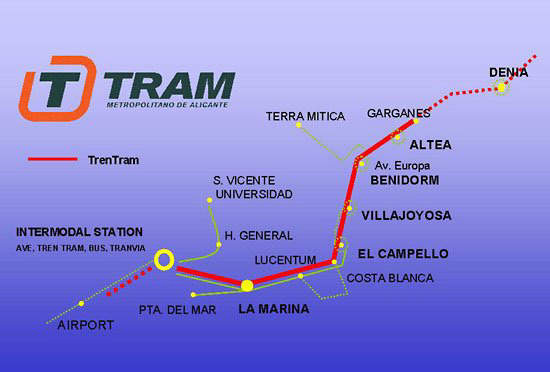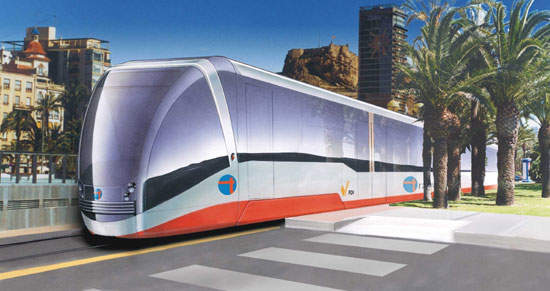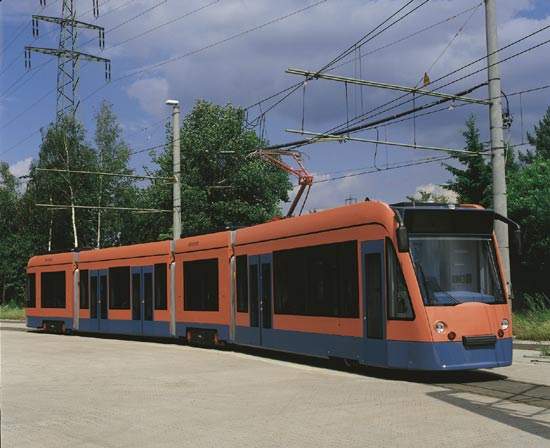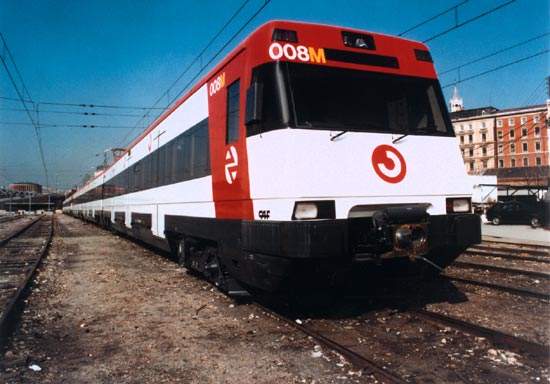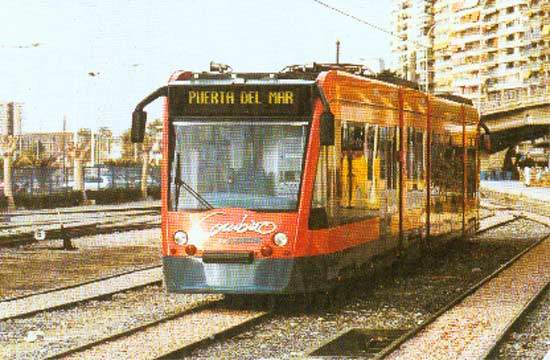Alicante and the surrounding region is a major tourist destination in south-east Spain with many popular resorts, including Benidorm, lining the Costa Blanca section of the Mediterranean coast north of the city. Public transport patronage has rocketed by 97% in just two years, demonstrating the value of the government’s long-term strategy of reducing the total market share of car travel to just a third by 2020.
The area has been served by a 93km (58-mile) metre-gauge secondary railway running from Alicante to Denia, but by the late-1990s the regional transport authority, Ferrocarriles de la Generalitat Valenciana (FGV) was examining ways of upgrading the railway and integrating more effectively into other transport modes.
By 1999, FGV had installed the first section of a planned ‘Tram-Train’ route along Alicante’s seafront from the city centre to Alacant-Puerta del Mar using hired trams. In 2001, the go-ahead was given for a €500 million masterplan, including extension of the tram line to meet the Alicante to Denia line and the electrification of the existing railway to allow through running as far as Altea, 51km (32 miles) from Alicante. Travelling time between the two points is reduced to around one hour.
INFRASTRUCTURE
The first investment in new infrastructure in Alicante was the electrification of the 2.5km (1.5-mile) Alicante to La Albufereta seafront tram route, completed in March 1999. The line was electrified at 750V DC and extended 700m to terminate at Alacant-Puerta del Mar.
Beyond this, the existing metre-gauge line from Albufereta to Altea is also being upgraded for a maximum speed of 100km/h (60mph) and electrified at 750V DC.
The existing seafront tram line between La Marina and El Campello closed between September 2002 and August 2003 for reconstruction. Since then, FGV metre-gauge diesel services have been cut back to El Campello and passengers currently transfer to a half hourly connecting tram service which takes 20 minutes to cover the 12.5km (7.8-mile) route with 11 stops. Despite this temporary arrangement, passenger numbers have rocketed by 97% and the tram is helping drive economic development along the route.
Infrastructure is a mixture of on-street running, segregated ground level tracks and metro style underground tunnels in the city centre.
One of the largest parts of the project will see the tram line in Alicante extended underground from its current terminus at La Goteta to a new multi-modal interchange at the RENFE main line station. Both the tram terminus and the RENFE station will be built underground and the area redeveloped as a transport interchange. The first 9.3km (5.8-mile) section to El Campello was given an opening date of spring 2004.
Construction of the €33.7 million phase 2 started in 2003, with underground stations at Museo Arqeuologico and Mercado built in marble.
ROLLING STOCK
Initially, services on the seafront tramway were worked by a hired Siemens Combino from Germany and another tram from Valencia. However, for the new tram-train service FGV ordered nine dual-mode light rail vehicles from Alstom capable of running at 70km/h (45mph) on tram lines and 100km/h (60mph) out of town.
The new 37m-long bi-directional trains have three articulated sections carried on four bogies, three of which are powered. With four doors on each side, access and egress is rapid and each vehicle carries 303 passengers, 99 seated.
The trains are assembled at Alstom’s Valencia plant, which also supplies mechanical parts and bogies, and traction equipment come from the company’s plant at Charleroi in Belgium.
FGV also ordered ten Siemens Combino trams for services on the city section but these were later exchanged with trams from Valencia. Tramcars maintained in former railway workshops at La Marina are being transferred to a new depot at Poble Espanyol.
SIGNALLING AND COMMUNICATIONS
Signalling is a mixture of ‘line of sight’ on the tramway sections and standard signals on the ‘heavy rail’ line where the route will be shared with diesel trains on the Alicante to Denia route.
THE FUTURE
FGV has plans to extend the network over several new branches at a cost of €500 million before 2010.
Line 2 branches 8km (5 miles) north at Mercado, serving the city’s main hospital, university and terminating in the San Vicente del Raspeig district with 13 stops. The Cap de l’Horta loop diverges from Line 1 at Albufuerta to serve residential areas at Lucentum and San Juan before rejoining at Costa Blanca.
Proposals also exist for the extension of services from the main station to Babel, with tram lines running alongside RENFE 1,668mm tracks.
The third phase extends the underground line from Mercado to a redeveloped RENFE main line station interchange. A cut-and-cover tunnel will take the trams under the Avenida de Alfonso el Sabio and Avenida General Marva with one intermediate station at Plaza de los Luceros.
From 2005 tram-train services over the route from Mercado to Villajoyosa, shared tracks with Line 1 trams in the city but only calling at Costa Blanca and El Campello underground stations before joining the upgraded metre-gauge railway. The remaining stub of the seafront tram route to Puerta del Mar gets a shuttle service from Mercado. Latest plans include services to the new underground interchange with RENFE main line services and the extension of tram-train services from Villajoyosa to Altea.

